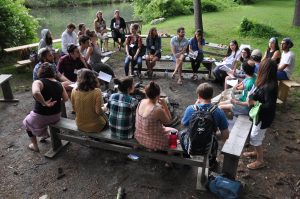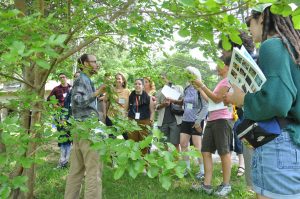The Benefits of Making Field Building a Team Sport
August 25th, 2016
I realize that one of the first rules in communications is, “Don’t bury the lead!” And yet, I feel compelled to begin with a bit of context before actualizing my metaphor. As a five-year transplant to the Bay Area, to say that I entered Warriors fandom in the good years would be a drastic understatement. Stephen Curry, ½ of the Splash Brothers, completed his 2nd MVP season; the Warriors took home the Championship in 2015 for the first time in 40 years following that with the first ever 73-win NBA season; and the ‘Dubs’ claim three All-Stars for the first time since 1976. The fact that the team is owned by a distant cousin who I have never met is not even a factor in my infatuation. With that in mind, it makes sense that my reading over the past weeks has been limited to FiveThirtyEight and ESPN’s plentiful array of exposés on Kevin Durant’s departure from Oklahoma City to Golden State for the 2016-2017 season. 
This may seem like a lot of effort to make a basketball metaphor for philanthropy, and it is. A month ago, at the first ever Jewish Outdoor, Food, Farming, and Environmental Education (JOFEE) gathering at Isabella Freedman Retreat Center, a group of practitioners and foundation professionals came together around the shared purposed of building the field. The Jim Joseph Foundation already shared some of the innovative learning and professional development that occurred, which certainly will help the field grow and mature. But another aspect of this gathering warrants an examination, because while at face value this type of gathering is not unique, a gathering that included such different funders is. Moreover, we were not there merely as listeners to a speaker or as observers of a conference; these varied funders, which included the Jim Joseph Foundation, joined with practitioners for focused and deliberate visioning and networking conversations.
The Gathering included representatives from the Atlanta Jewish Federation, Emanuel J. Friedman Philanthropies, Gendler Grapevine, the Leichtag Foundation, the Lucious Littauer Foundation, Hazon, Pearlstone Center, Urban Adamah, and Wilderness Torah. Just as each practitioner represented a different organization in this space—all of which complimented each other while not entirely duplicating efforts—each of the funders had a unique justification for its funding in this space. So how did we all end up there together?
As a starting point, the acronym—and the fact that the field itself is an acronym—presents opportunities for different funders. While the J O F E and E are certainly related in this context, they also are separate spaces unto themselves. Inherently, while all the organizations at that first meeting to some degree address farming, food justice, the environment, and other kinds of Jewish outdoor educational interventions, there are important strategic differences to recognize. Whereas the Emanuel J. Friedman Philanthropies (founders of Jewish Initiative for Animals) and the Leichtag Foundation (founders of the Coastal Roots Farm) see JOFEE funding as an end unto itself, for example, the Jim Joseph Foundation sees this investment as a means to funding its strategic priorities of educating Jewish educators and expanding opportunities for effective Jewish learning.
By making space for funders with different strategies and missions to come together, the field displayed a strength (and a potential for even greater strength) only possible by bringing together all of the letters of JOFEE. In this context, field leaders can engage more people in Jewish learning and life experiences; an individual will opt in even if just one part of JOFEE resonates with her or him. Yet, once they do, they open themselves up to other elements of JOFEE that may pique their interest and offer new ways to engage Jewishly. Additionally, since JOFEE essentially brings together even smaller, more narrow fields under one umbrella, the environment is ripe for experimentation, creativity, and collaborative Jewish education and engagement efforts.
A field with these organizing principles helps to overcome the issue of funders and practitioners being siloed based on specific foci that do not equate to the exact priorities of others in a similar space of the same field. Instead, the Gathering’s diverse group of funders and practitioners hypothesized together about a shared set of outcomes that were part of a 2022 Visioning Statement for the JOFEE field. As part of this process, each funder understood individual foundation priorities are part of a larger vision that could increase the overall influence that the organizations in that room have on the broader community. The result was a cohesive first conversation. Despite the differences in the organizations represented, each of the individuals in the room felt vested in the ultimate well-being of both the Jewish community and the underlying eco-concerns.
 As the Jim Joseph Foundation has discussed, collaboration comes with real challenges. Yet time and again we see that the benefits—creative initiatives; greater reach; more opportunities to scale and to become sustainable—outweigh these challenges. It is not unlike a basketball team where superstars come together, perhaps giving up solo fame and the chance to each score more, for the singular focus of winning a championship, which everyone on the Warriors wants to accomplish again, especially after a particularly disappointing Game 7 loss on June 19th (yes, I remember the date). The recruitment of Kevin Durant was not a singular coach speaking with a player. Amidst many dealmakers on both sides of the negotiation table, four long-tenured Warriors were all a part of the process and the effort to recruit Durant. Each of them knew that bringing him to the Bay Area would greatly increase their chances at another championship season while as a counter-point acknowledging that bringing this addition would likely reduce the shot attempts and general production value of several if not all of these four players.
As the Jim Joseph Foundation has discussed, collaboration comes with real challenges. Yet time and again we see that the benefits—creative initiatives; greater reach; more opportunities to scale and to become sustainable—outweigh these challenges. It is not unlike a basketball team where superstars come together, perhaps giving up solo fame and the chance to each score more, for the singular focus of winning a championship, which everyone on the Warriors wants to accomplish again, especially after a particularly disappointing Game 7 loss on June 19th (yes, I remember the date). The recruitment of Kevin Durant was not a singular coach speaking with a player. Amidst many dealmakers on both sides of the negotiation table, four long-tenured Warriors were all a part of the process and the effort to recruit Durant. Each of them knew that bringing him to the Bay Area would greatly increase their chances at another championship season while as a counter-point acknowledging that bringing this addition would likely reduce the shot attempts and general production value of several if not all of these four players.
Whether in the nonprofit world or the basketball world, a single funder or a single player has a ceiling on the amount of long-term success they achieve on their own. I am grateful to have been included in this initial gathering on behalf of the Jim Joseph Foundation, and to Hazon for assembling this group (which still is only a subset of the greater field). The field is stronger as a result.
Cross-posted in eJewishPhilanthropy